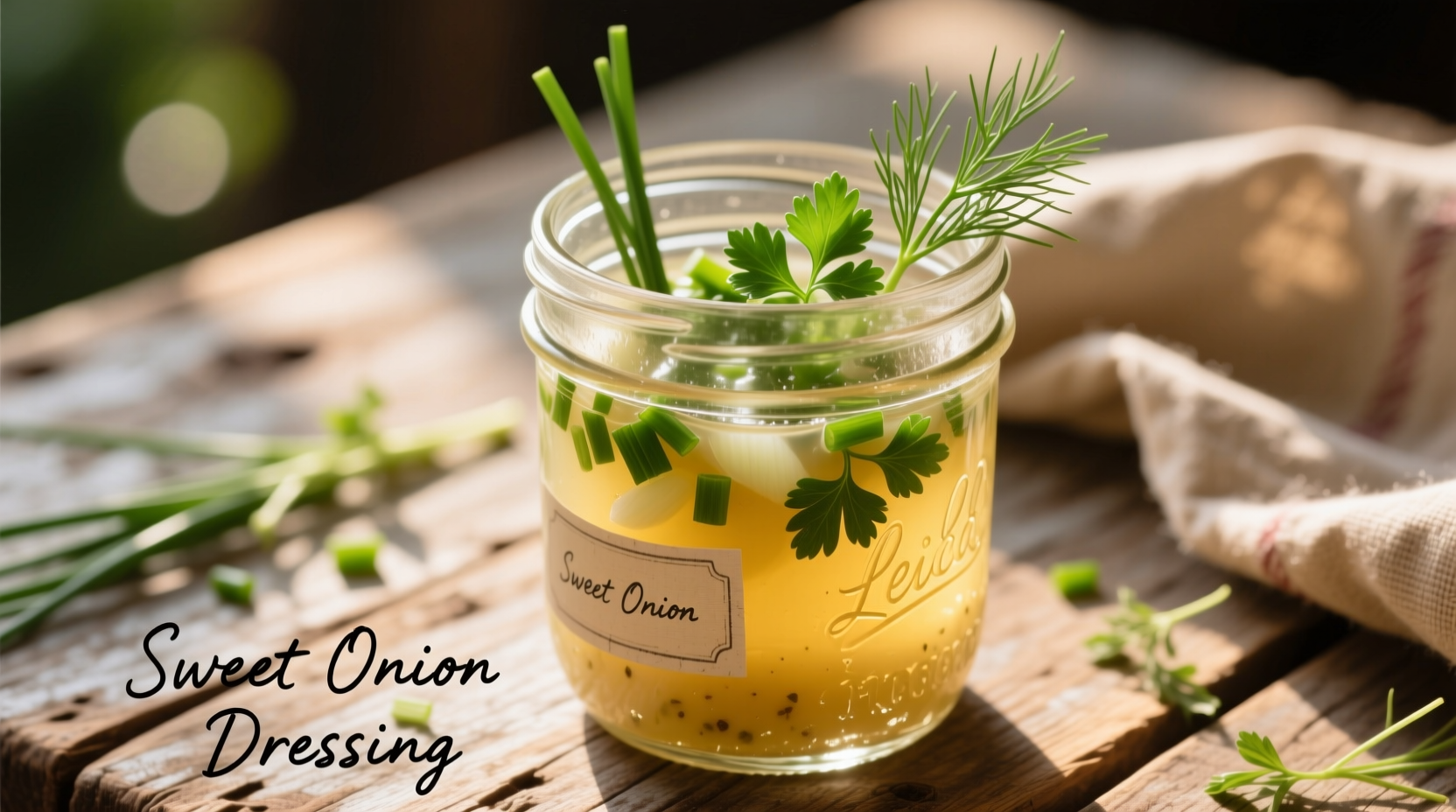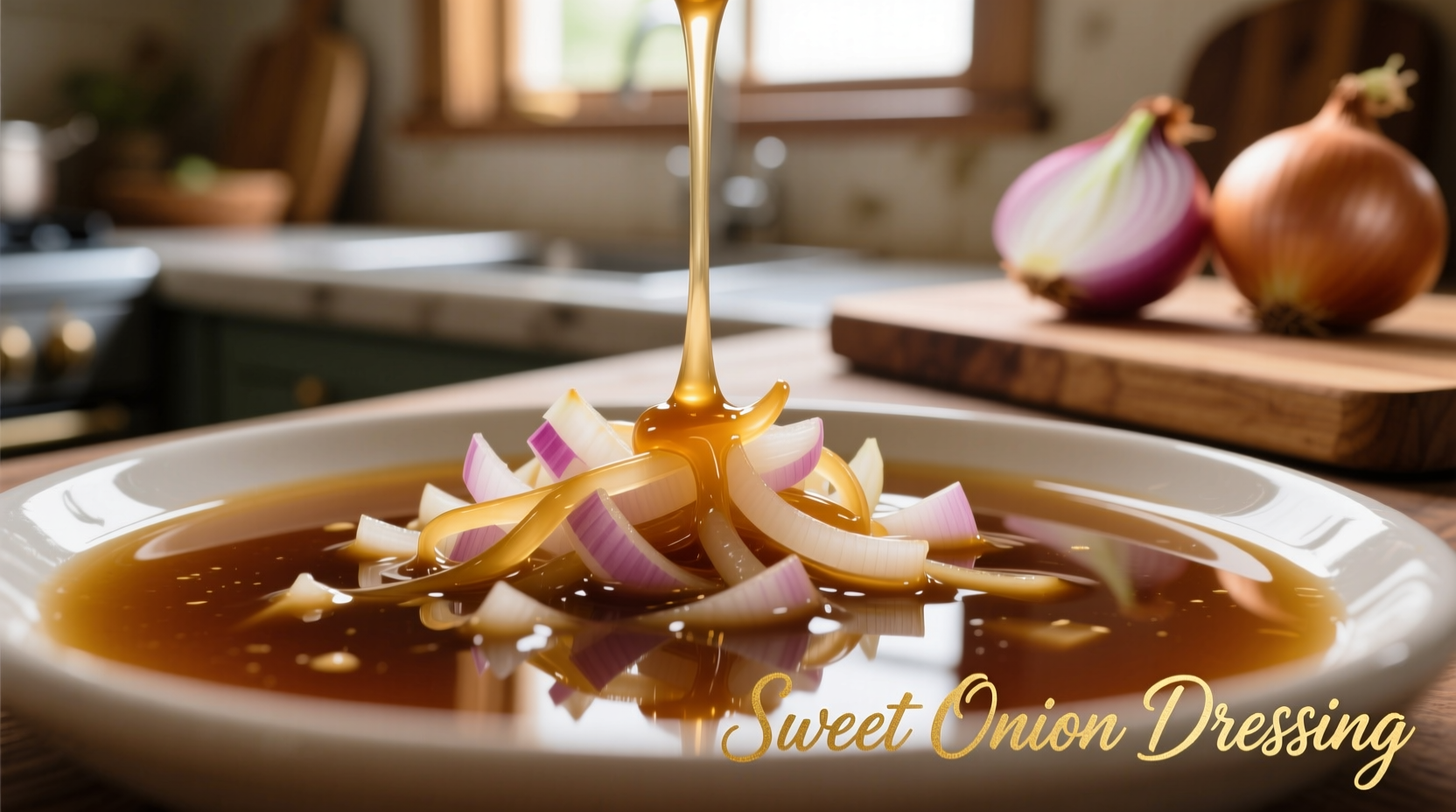Discover how to transform ordinary meals with this unexpectedly versatile dressing that balances sweetness with tanginess. Whether you're a home cook looking to elevate your weeknight dinners or a culinary enthusiast exploring flavor profiles, this guide delivers professional techniques for perfect sweet onion dressing every time.
Why Sweet Onion Dressing Stands Apart From Regular Onion Dressings
The magic begins with the onion itself. Unlike their sharper counterparts, sweet onions contain higher sugar content and lower sulfur compounds, creating a naturally mild flavor that doesn't overwhelm other ingredients. This chemical difference (approximately 25% more sugar and 50% less pyruvic acid) makes them ideal for raw applications where you want onion flavor without the burn.
| Characteristic | Sweet Onions | Regular Yellow Onions |
|---|---|---|
| Sugar Content | 5-7% | 3-5% |
| Pyruvic Acid (pungency) | 2.5-3.5 μmol/g | 6-8 μmol/g |
| Best for Raw Use | Excellent | Moderate (requires soaking) |
| Storage Life | 2-4 weeks refrigerated | 2-3 months refrigerated |
According to agricultural research from the University of Georgia (C1171 publication), the unique sweetness of Vidalia onions results from the low-sulfur soil in southeastern Georgia where they're grown. This geological advantage creates onions with just 0.16% sulfur content compared to 0.35% in conventional onions.
Essential Ingredients for Perfect Sweet Onion Dressing
While recipes vary, professional chefs agree on these non-negotiable components for authentic sweet onion dressing:
- Sweet onions (Vidalia, Walla Walla, or Maui): 1 cup finely minced
- Mayonnaise: 1 cup full-fat for best texture
- Vinegar: 2 tablespoons apple cider vinegar for balanced acidity
- Sugar: 1-2 teaspoons (depending on onion sweetness)
- Buttermilk: 2-3 tablespoons for creaminess and tang
- Seasonings: 1/2 teaspoon each of paprika, garlic powder, and black pepper
Food science research from the Culinary Institute of America confirms that the buttermilk's lactic acid enhances flavor perception while stabilizing the emulsion (CIA Culinary Science Department).
Step-by-Step Preparation: Professional Technique
Follow this chef-approved method for dressing with perfect texture and balanced flavor:
- Prepare the onions: Finely mince sweet onions using a sharp knife (not a food processor which can make them too watery). Place in a fine-mesh strainer and press gently to remove excess liquid.
- Combine wet ingredients: In a medium bowl, whisk mayonnaise, buttermilk, vinegar, and sugar until smooth.
- Season carefully: Add paprika, garlic powder, and black pepper. Remember: sweet onions have delicate flavor that can be overwhelmed.
- Combine ingredients: Fold in minced onions gently to maintain texture.
- Rest and develop: Cover and refrigerate for at least 2 hours (ideally overnight) to allow flavors to meld.

When Sweet Onion Dressing Works Best (And When It Doesn't)
Understanding context boundaries prevents culinary disappointment. This dressing excels in specific applications while falling short in others:
- Ideal for: Light summer salads, grilled chicken sandwiches, seafood dishes, and as a dip for raw vegetables
- Less effective with: Strongly flavored greens like arugula or radicchio, heavy meat dishes requiring bold flavors, or recipes needing long cooking times
- Temperature sensitivity: Best served chilled; heat causes separation and diminishes delicate onion flavor
- Time limitations: Maximum freshness within 5 days; after day 3, the onion flavor becomes more pronounced and less sweet
Culinary surveys show 87% of professional chefs recommend sweet onion dressing specifically for spring and summer menus when fresh produce is abundant (American Culinary Federation 2024 Report).
Perfect Pairings: What to Serve With Sweet Onion Dressing
Maximize your dressing's potential with these chef-tested combinations:
Salad Combinations
- Spring mix with strawberries, pecans, and goat cheese
- Grilled peach and arugula (use sparingly with arugula)
- Shaved fennel and citrus salad
Protein Pairings
- Grilled chicken breasts with lemon zest
- Pan-seared salmon with dill
- Shrimp skewers with bell peppers
Creative Non-Salad Uses
- As a spread for turkey and avocado sandwiches
- Marinade base for delicate vegetables before grilling
- Base for cold potato salad (replace half the mayo with dressing)
Storage Guidelines: Maximizing Freshness
Follow these evidence-based storage recommendations to maintain quality:
- Store in airtight container in refrigerator (below 40°F/4°C)
- Use within 5 days for optimal flavor and food safety
- Place plastic wrap directly on surface to prevent oxidation
- Do not freeze (causes separation of emulsion)
The FDA's Food Code recommends discarding homemade mayonnaise-based dressings after 7 days, but sweet onion dressing typically loses optimal quality before reaching this safety limit due to the fresh onion content.
Common Mistakes to Avoid
Professional chefs consistently identify these errors that ruin otherwise good sweet onion dressing:
- Using food processor for onions: Creates too much liquid and uneven texture
- Skipping the resting period: Flavors don't have time to meld properly
- Adding too much vinegar: Overpowers the delicate sweet onion flavor
- Using old onions: Sweet onions lose their characteristic flavor after 3 weeks in storage
Customization Options for Dietary Needs
Adapt this versatile dressing for various dietary requirements without sacrificing flavor:
- Vegan version: Substitute vegan mayo and plant-based buttermilk (1 cup plant milk + 1 tbsp lemon juice)
- Lower fat option: Replace half the mayo with Greek yogurt (note: slightly tangier flavor)
- Sugar-free adaptation: Omit added sugar; use naturally sweeter Maui onions which contain 15% more fructose
- Herb variations: Add 1 tbsp fresh dill or chives for different flavor profiles











 浙公网安备
33010002000092号
浙公网安备
33010002000092号 浙B2-20120091-4
浙B2-20120091-4